
|

|

|
Escape through Time
Fire |
Car |
Plane |
Ship
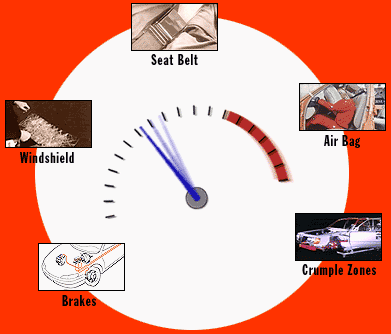
Brakes
The first cars had brakes only on the back wheels, which led
to much skidding and swerving. Like coaster brakes on a
bicycle, rear-only brakes needed long distances to bring the
vehicle to a complete stop. (In 1902, for instance, the
Automobile Club of America found that to stop a car going 20
mph required an average of 60 feet.) Brakes on all four wheels
did not appear in the United States until 1920, when they were
introduced in high-priced cars. It wasn't until the advent of
the new Ford Model A in 1927 that four-wheel brakes became
standard fare in most cars.
|
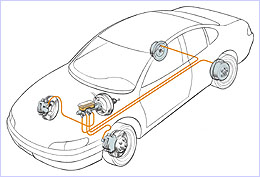 Instead of mechanical rods and cylinders, hydraulic
four-wheel brakes employ the use of fluid pressure to
actuate the brake pads of each of the wheels. Modern
brake systems split the hydraulics into two subsystems
to safeguard the complete loss of brakes.
Instead of mechanical rods and cylinders, hydraulic
four-wheel brakes employ the use of fluid pressure to
actuate the brake pads of each of the wheels. Modern
brake systems split the hydraulics into two subsystems
to safeguard the complete loss of brakes.
|
In the 1930s, hydraulic four-wheel brakes came into use. They
were an improvement over the mechanical variety, except that
when hydraulics were lost, so were all four brakes. Europe led
the way to a new system: dual hydraulic brakes. These systems
consisted of two parts: If a hydraulic leak occurred in one
part, the other could still function, albeit with less
efficiency. Despite their obvious utility, dual hydraulic
brakes weren't fully embraced in the United States until 1961,
when the American Motors Corporation built the system into all
of its cars. The 1950s marked the advent of power brakes,
which increase the amount of hydraulic pressure pushed towards
the master cylinder with the help of a booster. Most modern
brakes today consist of some combination of power and dual
hydraulic brakes.
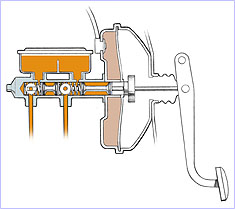 Power brakes involve the use of a master cylinder and
booster to improve the effectiveness of a car's
braking system. By creating an air vacuum within the
booster, a power brake can magnify the force of a
depressed brake pedal and apply greater fluid pressure
to the individual wheels.
Power brakes involve the use of a master cylinder and
booster to improve the effectiveness of a car's
braking system. By creating an air vacuum within the
booster, a power brake can magnify the force of a
depressed brake pedal and apply greater fluid pressure
to the individual wheels.
|
|
Until recently, however, braking on slippery surfaces was
still a risky proposition. Under such conditions, a braking
wheel might "lock up" in its position and begin to slide
without steering control. To combat this, automakers devised
anti-lock brakes. Relying on a computer to monitor the speed
of each wheel, the car can tell when a wheel is beginning to
slide and can apply an automatic series of braking pulses,
which are faster than those created by a human driver.
Anti-lock brakes can stop a car faster in such a situation
than a human driver can and also allow the driver to maintain
steering control.
back to top
Windshield
|
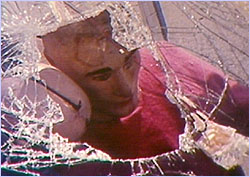 The use of plate glass in early windshields created
the danger of the "glass necklace," a situation in
whic passengers could fly headlong into and through
the windshield during a head-on collision.
The use of plate glass in early windshields created
the danger of the "glass necklace," a situation in
whic passengers could fly headlong into and through
the windshield during a head-on collision.
|
The earliest windshields, introduced by 1904, were folding
affairs. When mud, rain, or other substances blocked his or
her view forward, a driver could simply tip the top half down
for an unobstructed view. (Goggles came in handy in those
situations.) While the usefulness of windshields was clear to
everybody, they posed a serious danger. Manufacturers quickly
discovered that during an accident, their glass windshields
could shatter, sending a shower of sharp shards into the
vehicle. Glass windshields proved most hazardous during
front-end collisions, when passengers could end up smashing
headlong through the glass. Not surprisingly, when the first
cars with glass on all four sides were introduced, many people
were afraid to ride in them.
Early this century, two European scientists independently
invented a solution to deadly windshields. While working in
his lab, French scientist Edouard Benedictus accidentally
knocked a flask to the floor. To his amazement, the glass did
not break. Looking closer, he discovered that the chemical
that had been inside the flask, nitrocellulose, had dried up,
leaving an adhesive film that kept the numerous bits of
fragmented glass from separating. Benedictus went on to
develop a window consisting of two layers of plate glass held
together by layer of cellulose.
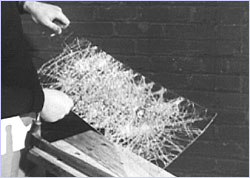 Laminated safety glass consisted of two layers of
plate glass held together by a layer of cellulose.
Laminated safety glass consisted of two layers of
plate glass held together by a layer of cellulose.
|
|
Meanwhile, on the other side of the channel, British inventor
John C. Wood had also been working with cellulose and had come
up with his own method for cementing a layer of celluloid
between two pieces of glass. Wood's shatter-resistant glass
came to be produced under the brand-name of Triplex. Though it
was first developed in 1905, Triplex was not brought to the
U.S. until 1926. A year later, Ford began incorporating
laminated glass into each of its automobiles.
In the 1950s, cars came off the line with side and rear
windows of tempered glass. Tempered glass is made by placing
one piece of glass into an atmospheric oven, which heats and
hardens the glass. This treated glass can withstand forces of
hundreds of pounds per square inch. When broken, it breaks
into smooth beads that do not cut the skin, and unlike safety
glass, rescuers can cut into it to reach victims trapped in a
car.
back to top
Seat Belt
|
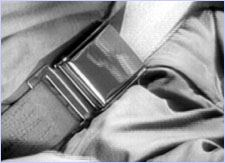 Early seat belts, sometimes known as lap belts
because they crossed over a passenger's lap, improved
the safety of the automobile passenger.
Early seat belts, sometimes known as lap belts
because they crossed over a passenger's lap, improved
the safety of the automobile passenger.
|
The seat belt was introduced in 1949 by Nash Motors, but it
was not until the mid-1950s that most automakers began
offering seat belts as optional safety features. These safety
belts crossed over a passenger's lap, securing him or her to
the seat in order to prevent a collision with the dashboard,
steering wheel, or windshield in an accident. While the seat
belt vastly improved a passenger's safety, it remained far
from perfect, and nasty head, spinal, and other injuries
continued to occur.
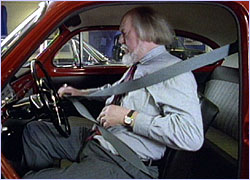 Nils Bohlin, inventor of the three-point belt,
demonstrates its ability to secure a passenger's torso
and center of gravity through a combination of the
principles behind lap and diagonal belts.
Nils Bohlin, inventor of the three-point belt,
demonstrates its ability to secure a passenger's torso
and center of gravity through a combination of the
principles behind lap and diagonal belts.
|
|
Recognizing this, Volvo designed a diagonal two-point belt.
Rather than simply securing your hips, the belt would hold
your upper torso to the chair as well. As they watched tapes
of crash tests, however, Volvo engineers realized the diagonal
belt was flawed. It crossed the body well above the center of
gravity. As the force of a collision rippled through the car,
the test dummy would slip downward and under the safety belt,
which became a kind of clothesline that caught the occupant's
neck and chin, resulting in neck injuries and possible
decapitation. To solve the problem, Volvo engineer Nils Bohlin
created the three-point seat belt. The lap belt held the body
in place while the diagonal shoulder belt kept the torso from
colliding with the structure of the car. First installed in
the 1959 Volvo, three-point seatbelts would not be required in
American cars for another decade.
In 1981, Mercedes-Benz improved the design by adding pre-crash
tensioners. Within milliseconds, seat belt pre-tensioners
tighten safety belts and help prevent belted occupants from
sliding and bouncing around during a crash. Six years later,
Mercedes-Benz, along with Audi, also added shoulder belt
height adjusters to provide a tighter fit.
Today, seat belts are recognized as a passenger's primary line
of defense. According to the U.S. National Highway Safety
Transportation Agency (NHSTA), lap/shoulder belts, when used
properly, reduce the risk of fatal injury to front-seat
passengers by 45 percent, and the the risk of
moderate-to-critical injury by 50 percent.
back to top
Air Bag
In 1952, after witnessing the speed at which a Navy torpedo
canvas could be filled by compressed air, John Hetrick was
granted the first patent for what would become the predecessor
to the airbag. Despite the airbag's obvious utility, it would
take nearly two decades for automakers to become convinced of
their importance.
|
 Through a series of crash tests, engineers and safety
experts determined what was needed to make the airbag
a successful safety feature.
Through a series of crash tests, engineers and safety
experts determined what was needed to make the airbag
a successful safety feature.
|
In 1970, the newly founded NHSTA, alarmed by the fact that
fewer than 15 percent of all Americans wore seatbelts, began
to look for new ways to protect accident victims. Hetrick's
airbag concept was seen by many as the ultimate passive
restraint, even though manufacturing safe airbags would
clearly be an enormous challenge. Engineers had to determine
how big the bag should be, what materials should be used in
it, and how to inflate it within 30 milliseconds after impact
without blowing it apart. These challenges were met, however,
and by 1980, Mercedes began offering airbags as standard
equipment. Eight years later, all U.S. car manufacturers were
required to follow suit.
By the late 1990s, a rising number of airbag-induced deaths
had created a new concern: the airbag itself could be
dangerous. The explosive force of a filling airbag was
powerful enough to injure and possibly kill both adults and
children. In almost every case, airbag injuries involved women
under 5'4" or adults and children who were either unbelted or
improperly restrained.
 As a solution to the growing number of airbag-induced
injuries, automakers devised a new design, which
incorporated the use of multiple sensors to calculate
the rate and speed of airbag deployment. Depending on
circumstances, airbags would engage one, two, or no
initiators.
As a solution to the growing number of airbag-induced
injuries, automakers devised a new design, which
incorporated the use of multiple sensors to calculate
the rate and speed of airbag deployment. Depending on
circumstances, airbags would engage one, two, or no
initiators.
|
|
In late-model autos, a computer decides how airbags should
deploy. It uses an electronic scale that directs the bag to
deploy only if the rider is above a certain weight, and it can
deploy at two different speeds using one of two initiators. In
a minor accident, only one initiator fires, and the bag
inflates more softly and to a smaller size; in a high speed
accident, both initiators fire.
back to top
Crumple Zones
The same year that Volvo engineer Nils Bohlin invented the
three-point safety belt, Bela Berenyi, an engineer at
Mercedes, came up with a safety concept that would completely
change how cars were designed and built. Prior to 1959, people
believed the stronger the structure, the safer the car. But in
actuality, such construction proved deadly to passengers,
because the force from impact went straight inside the vehicle
and onto the passenger. Berenyi knew that he would have to
find a way to dissipate the force of a crash before it reached
the passenger. In the end, he designed two "crumple
zones"—one in the front of a car and one in the back.
Crumple zones relied on a skeletal frame of special materials
that would crumple in predictable ways, absorbing the energy
of a collision.
|
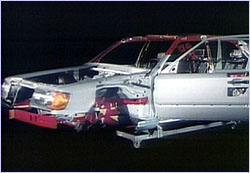 Crumple Zones, indicated here in red, were designed
to absorb the energy of a collision by bending and
breaking in a predictable manner. In doing so, the
force of the collision would be diverted away from the
passenger's compartment, thereby keeping him or her
from serious injury.
Crumple Zones, indicated here in red, were designed
to absorb the energy of a collision by bending and
breaking in a predictable manner. In doing so, the
force of the collision would be diverted away from the
passenger's compartment, thereby keeping him or her
from serious injury.
|
First introduced in 1959, crumple zones with rigid cabs are
now the standard in every car made throughout the world. In
the event of a severe frontal collision, the frontal frames
that support the engine are designed to slide underneath the
passenger's compartment. In combination with the crumple
zones, the passenger compartment is often built using
high-tensile steel, which creates a rigid passenger cell often
referred to as a "safety cage." This is enhanced by new
side-impact beams, which are found within car doors.
Previously, in extreme side impacts, these beams could bend
and protrude dangerously into the interior. So companies
developed a special side-impact beam that breaks after
absorbing impact energy.
back to top
Photos/Illustrations: (1,2) George Retseck; (3) Aims
Multimedia; (4) Libbey Owens Ford; (5) National Safety
Council; (6,8,9) NOVA/WGBH Educational Foundation; (7,10)
Mercedes Benz.
Escape Through Time
| Skydive |
Human Response
Survivor Stories
|
Pioneers of Survival
|
Survival Strategies
Resources |
Teacher's Guide
|
Transcripts
| Site Map |
Escape! Home
Editor's Picks
|
Previous Sites
|
Join Us/E-mail
|
TV/Web Schedule
About NOVA |
Teachers |
Site Map |
Shop |
Jobs |
Search |
To print
PBS Online |
NOVA Online |
WGBH
©
| Updated November 2000
|
|
|




 Instead of mechanical rods and cylinders, hydraulic
four-wheel brakes employ the use of fluid pressure to
actuate the brake pads of each of the wheels. Modern
brake systems split the hydraulics into two subsystems
to safeguard the complete loss of brakes.
Instead of mechanical rods and cylinders, hydraulic
four-wheel brakes employ the use of fluid pressure to
actuate the brake pads of each of the wheels. Modern
brake systems split the hydraulics into two subsystems
to safeguard the complete loss of brakes.
 Power brakes involve the use of a master cylinder and
booster to improve the effectiveness of a car's
braking system. By creating an air vacuum within the
booster, a power brake can magnify the force of a
depressed brake pedal and apply greater fluid pressure
to the individual wheels.
Power brakes involve the use of a master cylinder and
booster to improve the effectiveness of a car's
braking system. By creating an air vacuum within the
booster, a power brake can magnify the force of a
depressed brake pedal and apply greater fluid pressure
to the individual wheels.
 The use of plate glass in early windshields created
the danger of the "glass necklace," a situation in
whic passengers could fly headlong into and through
the windshield during a head-on collision.
The use of plate glass in early windshields created
the danger of the "glass necklace," a situation in
whic passengers could fly headlong into and through
the windshield during a head-on collision.
 Laminated safety glass consisted of two layers of
plate glass held together by a layer of cellulose.
Laminated safety glass consisted of two layers of
plate glass held together by a layer of cellulose.
 Early seat belts, sometimes known as lap belts
because they crossed over a passenger's lap, improved
the safety of the automobile passenger.
Early seat belts, sometimes known as lap belts
because they crossed over a passenger's lap, improved
the safety of the automobile passenger.
 Nils Bohlin, inventor of the three-point belt,
demonstrates its ability to secure a passenger's torso
and center of gravity through a combination of the
principles behind lap and diagonal belts.
Nils Bohlin, inventor of the three-point belt,
demonstrates its ability to secure a passenger's torso
and center of gravity through a combination of the
principles behind lap and diagonal belts.
 Through a series of crash tests, engineers and safety
experts determined what was needed to make the airbag
a successful safety feature.
Through a series of crash tests, engineers and safety
experts determined what was needed to make the airbag
a successful safety feature.
 As a solution to the growing number of airbag-induced
injuries, automakers devised a new design, which
incorporated the use of multiple sensors to calculate
the rate and speed of airbag deployment. Depending on
circumstances, airbags would engage one, two, or no
initiators.
As a solution to the growing number of airbag-induced
injuries, automakers devised a new design, which
incorporated the use of multiple sensors to calculate
the rate and speed of airbag deployment. Depending on
circumstances, airbags would engage one, two, or no
initiators.
 Crumple Zones, indicated here in red, were designed
to absorb the energy of a collision by bending and
breaking in a predictable manner. In doing so, the
force of the collision would be diverted away from the
passenger's compartment, thereby keeping him or her
from serious injury.
Crumple Zones, indicated here in red, were designed
to absorb the energy of a collision by bending and
breaking in a predictable manner. In doing so, the
force of the collision would be diverted away from the
passenger's compartment, thereby keeping him or her
from serious injury.